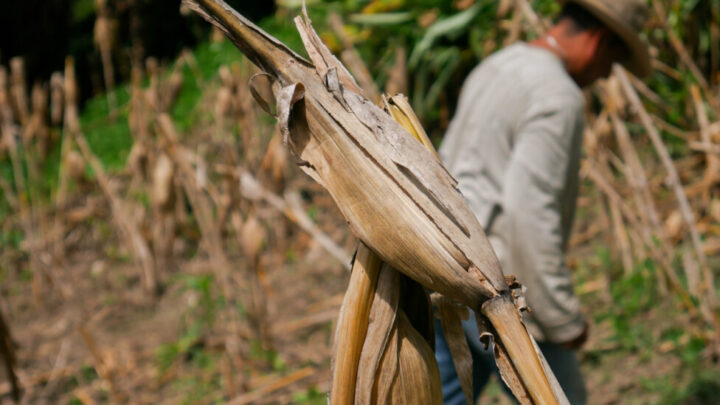El Ni Impact on Central America’s Small Farmers Is Becoming More Intense — Global Issues
SANTA MARÃA OSTUMA, El Salvador, Oct 10 (IPS) – The effects of El Niño on agriculture in Central America are once again putting pressure on thousands of small farmer families who are feeling more vulnerable economically and in terms of food, as they lose their crops, due to climate change.
But that is not all. In addition to the obvious fact that poor harvests lead to higher food prices and food insecurity, they also generate a lack of employment in the countryside, further driving migration flows, said several experts interviewed by IPS.
The El Niño Southern Oscillation (ENSO) weather phenomenon had not been felt in the area since 2016. But now it has reappeared with stronger impacts. Meteorologists define ENSO as having three phases, and the one whose consequences are currently being felt on the ground is the third, the strongest.
Impact on the families
“The lack of water made us plant later, in June, when a drought hit us and ruined our corn and beans,” Gustavo Panameño, 46, told IPS as he looked disconsolately at the few plants still standing in his cornfield.
The plot Gustavo leases to farm, less than one hectare in size, is located in Lomas de Apancinte, a hill in the vicinity of Santa María Ostuma, in the central Salvadoran department of La Paz.
“The beans were completely lost, I expected to harvest about 300 pounds,” he said.
The corn and bean harvest “was for the consumption of the family, close relatives, and from time to time to sell,” said Gustavo.

Nearby is the plot leased by Héctor Panameño, who almost completely lost his corn crop and the few beans he had planted.
Corn and beans form the basis of the diet of the Salvadoran population of 6.7 million people and of the rest of the Central American countries, which have a total combined population of just over 48 million.
This subtropical region has two seasons: the wet season, from November to April, and the dry season the rest of the year. Agriculture contributes seven percent of GDP and accounts for 20 percent of employment, according to data from the Central American Integration System (SICA).
“I lost practically all the corn, and the beans too, they couldn’t be used, they started to grow but were stunted,” said Héctor, 66, a distant relative of Gustavo.
At this stage, the stalks of the corn plants have already been “bent”, a small-farming practice that helps dry the cobs, the final stage of the process before harvesting.
And what should be a cornfield full of dried plants, lined up in furrows, now holds barely a handful here and there, sadly for Héctor.
Both farmers said that in addition to the droughts, the crops were also hit by several storms that brought with them violent gusts of wind, which ended up knocking down the corn plants.
“The plants were already big, 45 days old, about to flower, but a windstorm came and knocked them down,” recalled Héctor, sadly.
“After that, there were a few plants left standing, and when the cobs were beginning to fill up with kernels another strong wind came and finished knocking down the entire crop.”
A few weeks ago both Gustavo and Héctor replanted corn and beans, trying to recover some of their losses. Now their hopes are on the “postrera”, as the second planting cycle is called in Central America, which starts in late August and ends with the harvest in November.
The windstorms mentioned by both farmers are apparently part of the extreme climate variability brought by climate change and El Niño.

El Niño 2.0
“It’s part of the same process, the warming of the water surface generates those winds,” said Pablo Sigüenza, an environmentalist with the National Network for the Defense of Food Sovereignty of Guatemala (REDSAG).
Guatemala is also experiencing what experts have noted in the rest of the region: because El Niño has arrived in the “strong phase”, in which climate variability is even more pronounced, there are periods of longer droughts as well as more intense rains.
That puts the “postrera” harvest in danger, said the experts interviewed.
This means that whereas El Niño would bring drought in the first few months of the agricultural cycle, now it is hitting harder during the second period, in August, when the postrera planting is in full swing.
“For the farmers it was clear since April that it was raining less, compared to other years,” Sigüenza told IPS from Guatemala City.
“Then, in August, we had the first warnings from the highlands and the southern coast that the plants were not growing well, that they were suffering from water stress,” he said.
The most affected region, he said, is the Dry Corridor, which in Guatemala includes the departments of Jalapa, Chiquimula, Zacapa, El Progreso, part of Chimaltenango and Alta Verapaz, in the central part of the country.
The Dry Corridor is a 1,600 kilometer-long strip of land that runs north-south through portions of Mexico, Guatemala, Honduras, El Salvador, Nicaragua and Costa Rica.
It is an area highly vulnerable to extreme weather events, where long periods of drought are followed by heavy rains that have a major effect on the livelihoods and food security of local populations, as described by the United Nations Food and Agriculture Organization (FAO).
Sigüenza said that food security due to lack of basic grains is expected to affect some 4.6 million people in Guatemala, a country of 17.4 million.
Even the U.S. National Oceanic and Atmospheric Administration (NOAA) “predicted that August, September and October would be the months with the greatest presence of El Niño,” said Luis Treminio, president of the Salvadoran Chamber of Small and Medium Agricultural Producers.
Treminio said that 75 percent of bean production is currently planted, and because it is less resistant to drought and rain than corn and sorghum, there is a greater possibility of losses.
“So the risk now is to the postrera, because if this scenario is fulfilled, we will have a very low postrera production,” he said.
Treminio’s estimate is that El Salvador will have a basic grains deficit of 6.8 million quintals, which the country will have to cover, as always, with imports.

Nicaragua, hardest hit
Nicaragua, population 6.8 million, is the Central American country hardest hit by El Niño, Brazilian Adoniram Sanches, FAO’s subregional coordinator for Mesoamerica, told IPS.
As in other countries in the region, Nicaraguan farmers suffered losses in the first planting, in May, and again in the second, the postrera, “and all of this leads to a strong imbalance in the small farmer economy,” the FAO official said from Panama City.
Sanches said that El Niño will be felt in 93 percent of the region until March 2024 and, in addition, 71 percent is in the “strong phase”.
He added that in the Dry Corridor 64 percent of the farms are less than two hectares in size. In other words, there are many families involved in subsistence agriculture, and with fewer harvests, they would face unemployment and would look for escape valves, such as migration.
“All this would then trigger an explosion of migration,” said Sanches.
With regard to the impacts in Nicaragua, researcher Abdel Garcia, an expert in climate, environment and disasters, said that, in effect, the country is receiving “the negative backlash” of El Niño, that is, less rain in the months that should have more copious rainfall, such as September.
García said that the effects of the climate are not only being felt in agriculture, and therefore in the economy, but also in the environment.
“The ecosystem is already suffering: we see dried up rivers and surface water sources, and also the reservoirs, which are at their lowest levels right now,” García told IPS from Managua.
García said that some farmers in the department of Estelí, in northwestern Nicaragua, are already talking about a plan B, that is, to engage in other economic activities outside of agriculture, given the harsh situation in farming.
In late August, FAO announced the launch of a humanitarian aid plan aimed at mobilizing some 37 million dollars to assist vulnerable communities in Latin America in the face of the impact of the El Niño phenomenon.
Specifically, the objective was to support 1.1 million people in El Salvador, Guatemala, Honduras, Nicaragua, Bolivia, Colombia, Ecuador, Peru and Venezuela.
Even more ambitious is an initiative in which FAO will participate as a liaison between the governments of 30 countries around the world and investors, multilateral development banks, the private sector and international donors, so that these nations can access and allocate resources to agriculture.
At the meeting, which will take place Oct. 7-20 in Rome, FAO’s world headquarters, governments will present projects totaling 268 million dollars to investors.
Among the nations submitting proposals are 10 from Latin America and the Caribbean, including Guatemala, Honduras, El Salvador and Nicaragua.
Meanwhile, despite the gloomy forecasts for farming families, who are taking a direct hit from El Niño, both Gustavo and Héctor remain hopeful that it is worth a second try now that the postrera harvest is underway.
“We have no choice but to keep working, we can’t just sit back and do nothing,” said Héctor, with a smile that was more encouraging than resigned.
© Inter Press Service (2023) — All Rights ReservedOriginal source: Inter Press Service
Check out our Latest News and Follow us at Facebook
Original Source







